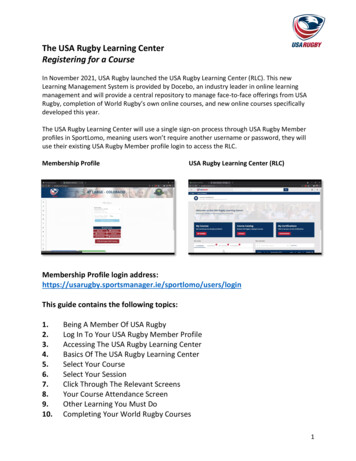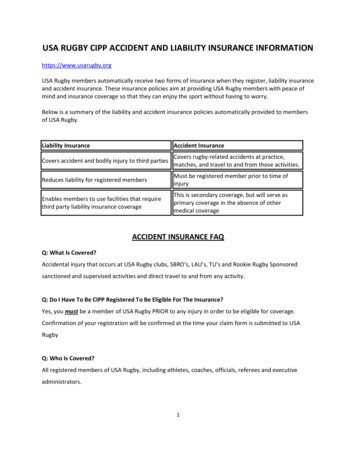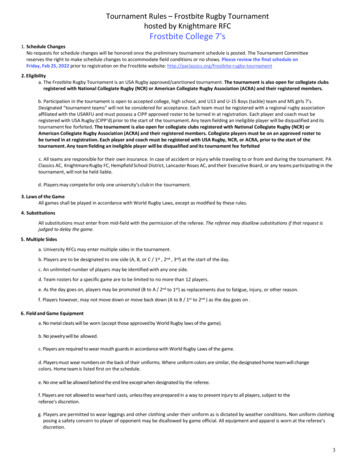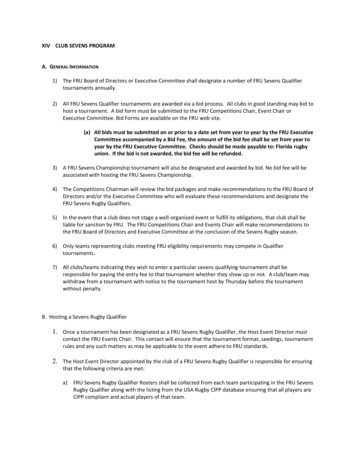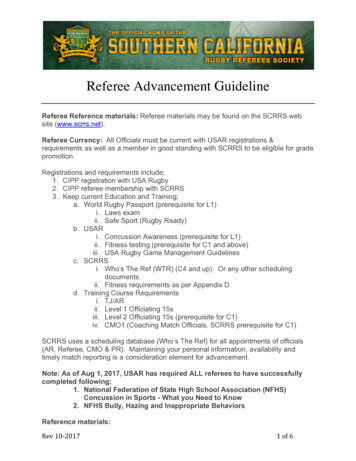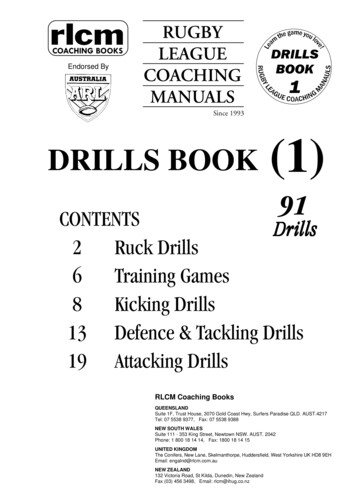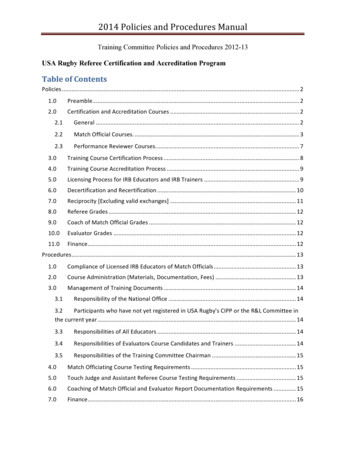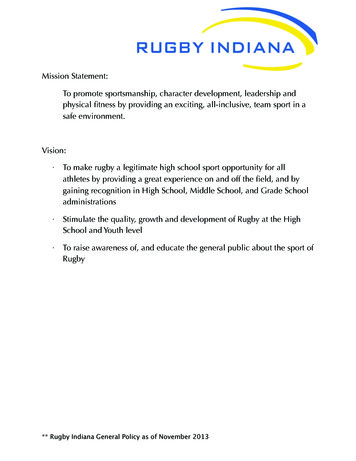
Transcription
Research Supporting theBenefits of CatholyteProduced Through ElectrolysisNATURAL DETERGENTAND CLEANING AGENT14301 N 87th Street, Suite 301 Scottsdale, AZ 85260p. 833.333.SANY(7269) info@sanyspray.com www.sanyspray.com
CATHOLYTE SCIENCE RESEARCH ARTICLESTABLE OF CONTENTS1. Research of Catholyte Water on Experimental Graffi Tumor onHamsters. Kangen Device for Catholyte Water2. The-Green-Solution3. Effects of electrochemically activated water catholyte and anolyte onhuman health4. Minimizing microbial contamination risk simultaneously from multiplehospital washbasins by automated cleaning and disinfection of U-bendswith electrochemically activated solution5. Cleaning Effectiveness of Root Canal Irrigation
Journal of Medicine, Physiology and BiophysicsISSN 2422-8427 An International Peer-reviewed JournalVol.59, 2019www.iiste.orgDOI: 10.7176/JMPBResearch of Catholyte Water on Experimental Graffi Tumor onHamsters. Kangen Device for Catholyte WaterIgnat IgnatovScientific Research Center of Medical Biophysics (SRCMB), BulgariaAbstractThe paper describes the results of a pilot study aimed at the investigation of the influence of catholyte(electrolyzed alkaline water) on the development of tumors. In the experiments solid Graffi tumor wastransplanted subcutaneously in the back of the experimental group of Golden Syrian hamsters. Tumorappearance and growth were registered every day. Blood parameters were measured on the 10th and 25th dayafter transplantation and blood smears were prepared. Hamsters treated with catholyte developed tumor withsome delay compared to untreated (drinking tap water) ones. Also, the tumor growth was slow and the survivalrate was increased. The analysis of blood parameters and cell morphology has shown significant differences inthe value of some hematometric parameters and morphological changes of some blood cells. The obtainedresults suggest about the beneficial influence of catholyte and the possible use of it as a supporting non-invasivetherapy of cancer diseases.The studies of the author show that the highest quality of Catholyte water if fromdevice Kangen. The research of effect on Experimental Graffi Tumor on Hamsters is with co-authors RenetaToshkova, Elissaveta Zvetkova and Georgi Gluhchev.Keywords: Graffi tumor, catholyte, tumor growth, survival rate, mortality, blood parameters.DOI: 10.7176/JMPB/59-01Publication date:September 30th 20191. IntroductionWater is a natural and necessary medium for many biological molecules. Changes in its composition andstructure can produce stimulating or inhibitory effects on the processes in the living things. Influenced bydifferent factors water can change its acidity pH, ORP (Oxidation Reduction Potential), and its physical structure.When electrochemical activation or electrolysis is applied the obtained catholyte receives high level of pH andnegative ORP which leads to increased antioxidant effect. Due to this reason it could be expected that thecatholyte would have protective and positive effect for oxidative stress-related diseases like diabetes and cancer.Clinical examinations carried out by different scientists have demonstrated positive effect in case ofdiabetes type 2, telomere shortening in cancer cells and inhibition of their growth, suppression of side effectscaused by the use of anticancer medications, favorable influence on the blood cells . Along with this it wasproved that the activated water was not toxic for cells and tissues, and did not have mutagenic, cancerogenic,embryotoxic or immunotoxic effects.For the evaluation of the influence of some medicine or therapy on tumor malignancies different parametersare used based on measurements of tumor development, survival rate, mortality, blood cells changes and others.In the last decade, the main hematometric indices (biomarkers) have been evaluated as diagnostic tools andprognostic parameters in patients with malignancies – cancer and leukemia.Recent data from the scientific oncological literature evaluated that the NLR (neutrophil to lymphocyteratio) is superior for predicting the long term survival of cancer patients . E.g., lower NLR ( 2.0) is associatedwith good prognosis for breast cancer patients; a higher peripheral blood NLR ( 5) was considered to indicate –significantly and independently, a poor prognosis for breast cancer patients, gastric cancer patients, etc.Simultaneously, the total WBC count, absolute neutrophil- and lymphocyte counts alone, could be alsostatistically significant predictors of 5-year cancer patients’ mortality.At present, the data about the effects of electrolyzed alkaline water (catholyte) on tumor growth andhematological parameters in experimental tumor-bearing animals are absent.The aim of this study is to examine the biological effects of catholyte on the tumor growth parameters,hematometric biomarkers (including main WBC count; absolute granulocyte; lymphocyte count; granulocyte;lymphocyte % (percent), GLR (granulocyte to lymphocyte ratio), and blood cell morphology in hamsters withexperimental Graffi myeloid tumor.The authors have research of the project for influence with electromagnetic fields and infrared thermalfields on Graffi tumor [15, 16].2. Materials and Methods2.1. Experimental animalsIn the trials hamsters, breed “Golden Syrian”, aged 2-4 months, male and female, with weight around 100 g,grown in individual plastic cages with free access to food and water were used1
Journal of Medicine, Physiology and BiophysicsISSN 2422-8427 An International Peer-reviewed JournalVol.59, 2019www.iiste.orgDOI: 10.7176/JMPB2.2. Experimental tumorThe experimental Graffi solid tumor is maintained on a monthly basis in vivo in hamsters from the research teamat IEMPAM-BAS (17) via subcutaneous (s.c.) transplantation of live tumor cells ((1-2.106) in the area of theback. Between days 7 and 15 in the spot of injection appear tumors, which grow progressively, and the hamstersdie aproximately 30-35 days after the injection of tumor cells. In such a tumor model it is observed 100%attachment/appearance (transplantability) of umor and 100% mortality rate. Spontaneous regression, i.e.spontaneous shrinking and disappearance of the tumor is not observed.2.3. Catholyte waterDuring the experiment catholyte water was produced every day using the Actvator-2 device, developed in theInstitute of Information and Communication Technologies at the Bulgarian Academy of Sciences. In this wayacidity pH of the water was kept between 9.0 and 9.5.2.4. Experimental design.All the animals were divided into 4 groups each of 6 animals, as follows.Gr.1 The hamsters from this group started drinking catholyte water 10 days before the injection with 5х104Graffi tumor cells per hamster in the back area, and continued drinking it until the end of the experiment.Gr.2. This group was used as a control. The hamsters from it were s.c. injected with the same amount of tumorcells on the 10th day of the experiment as the hamsters from Gr.1, and were receiving tap water all the time.Gr.3 consisted of healthy hamsters drinking catholyte water during the experiment.Gr.4 consisted of healthy hamsters drinking tap water all the time.The first two groups have to reveal the influence of the catholyte water on the appearance andgrowth of transplanted tumor compared to the tap water, as well as for evaluation of haematological parametersand peripheral blood cell morphology.The last two groups were used as control for hematological research.Measured parametersThe following parameters of tumor development are determined:- tumor transplantability success (% of hamsters with tumor to the total number of injected ones),- tumor size (the average diameter of tumor measured with caliper in mm),- survival and average survival (calculated for the respective group in days),- lethality (% of dead animals in the group).Animals from each group were sacrificed preserving the ethical aspects of the European convention forprotection of vertebrate animals, used for experimental and other scientific purposes (OJ L 222), and approvedby the National Veterinary Medical Office in Bulgaria, and blood samples have been prepared at different timeperiods: on days 10 and 25 after Graffi tumor implantation. Hematological/hematometric parameters and indicesas shown in Fig.1 were measured on the automated hematological analyzer BC-2800 Vet (Mindray, China).The WBC/LR (White blood cells to Lymphocyte ratio and NLR (Neutrophil to lymphocyte ratio) werecalculated.2.5. Statistical analysisFor the evaluation of the significance of the differences between the average values of a specific parameter t-testwas used at levels of significance α 0.10 and α 0.05, respectively.2.6. Research with spectral analyses with methods DNES and NES and chemical compositions ofCatholyte water with different types of Catholyte waterThe device for DNES spectral analysis based on an optical principle was designed by A. Antonov. For this, ahermetic camera for evaporation of water drops under stable temperature ( 22–24 0С) conditions was used. Thewater drops were placed on a water-proof transparent pad, which consisted of thin maylar folio and a glass plate.The light was monochromatic with filter for yellow color with wavelength at 580 7 nm. The devicemeasures the angle of evaporation of water drops from 72.30 to 00. The DNES-spectrum was measured in therange of -0.08– -0.1387 eV or 8.9–13.8 µm using a specially designed computer program. The mainestimation criterion in these studies was the average energy ( EH.O) of hydrogen O.H-bonds between H2Omolecules in water samples with waters Catholyte,3. Results3.1. Parameters of tumor growth for Gr.1 and Gr.2.Catholyte water was used as experimental therapy during two months. Animals have been examined every dayuntil tumor detection and 2 times per week until 30 days after tumor transplantation. The tumor growth2
Journal of Medicine, Physiology and BiophysicsISSN 2422-8427 An International Peer-reviewed JournalVol.59, 2019www.iiste.orgDOI: 10.7176/JMPBparameters have been registered regularly. The differences between the two groups are shown on (Figure.1).Tumor size (mm)35Gr1- with CWGr2 -control (tap W)Tumor size (mm)Transplantability (%)Transplantability (%)1009080706050403020100Gr1 -with CWGr2 -control (tap W)30252015105077 8 9 10 11 12 13 14 15 16 17 18 19 2091113151719212325daysdaysBALethality (%)Letality (%)100908070605040302010020Gr1- with CWGr2 -control(tap W)25303540455055DaysCSurvival rate5550454035302520151050Survival rate (%)DaysMST100Gr1.with CW90Gr2. - control (tap W)8070605040302010030 32 34 36 38 40 42 44 46 48 50 52 54Time (days)Gr 1 -with CWGr 2 -control (tap W)EDFigure 1. Biometric parameters of tumor growth for the hamsters from Gr.1 and Gr.2: А-transplantability in %;В- tumor size in mm; C- lethality in %; D- average survival time (AST) in days; E - Survival rate.As can be seen from the graph on (Figure 1A) the tumor transplantation was delayed for the hamsters takingcatholyte. While all the hamsters from Gr.2 developed tumor on the 12th day this happened only for 1/3 ofhamsters from Gr.1. In the hamsters receiving catholite, tumors were detected at 100% on day 20.Similar effect is observed for the tumor size (Figure 1B). Until the 10th day was not establishedsubcutaneous firmness in none of the hamsters drinking catholyte. This group showed an inhibition in tumorgrowth rate as compared to control throughout the study period.The increased lethality for the hamsters (Figure.1C) shows from Gr.2 after 35 days, compared with thehamsters from Gr.1. The control group (Gr.2) had a 100% mortality on day 41, while in the group 1 - on the 53rd day of the study.The evaluated average survival for Gr.1 is 43.4 6.9 days, while it is 37.5 4.5 days for Gr.2. Sameconclusion could be taken from (Figure.1E).These data suggest that the catholyte water slows down tumor development and as a result increasessurvival rate.3
Journal of Medicine, Physiology and BiophysicsISSN 2422-8427 An International Peer-reviewed JournalVol.59, 2019www.iiste.orgDOI: 10.7176/JMPBThe illustrations on (Figure.2) give visual impresion for the tumor development in Gr.1 and Gr.2.Figure 2. Images of hamsters from Gr.1 (upper line) and Gr.2 (bottom line) taken on the 25th day after the tumortransplantation.3.2. Hematological parametersHamsters from the trial and control groups were euthanised after the application of deep anaesthesia on the 10thand 25th day after tumor transplanting. The obtained blood was used to report hematological parameters, forserum and preparation of blood smears.The evaluated parameters for all groups are displayed in (Table 1).Table 1. Blood parameters of 10th/25th day of study4
Journal of Medicine, Physiology and BiophysicsISSN 2422-8427 An International Peer-reviewed JournalVol.59, 2019www.iiste.orgDOI: 10.7176/JMPBThe developing experimental Graffi myloid tumor in hamsters influenced diversely the two main WBCsubpopulations – neutrophil granulocytes and lymphocytes (column 4). Significantly elevated WBC, granulocytecount and granulocyte number (%) as well as significant reduction of absolute lymphocyte count and lymphocytenumber (%) were observed in the Graffi myeloid tumor-bearing hamsters (Gr.2, column 4) and (Figure 3). Theseeffects are well expressed on the day 15-th, and are profound on the 25-th day in our experimental model. Thetreatment of tumor bearing animals with catholyte as drinking water improved the values of same parametersduring the investigation (Gr.1, column 3) and (Figure 3).The mean values and standard deviations of some parameters are shown in Table 2.Parameter Lymp%Mon%Gran%RBCMCHCPDWmsmsmsmsmsmsGr.168.914.9 5.48 0.78 25.65 14.17 30.07 406019.8 0Gr.214.65 2.61 7.90.85 77.45 1.765.18 0.57 33318.33 18.1 0.28Table 2. Mean values and standard deviations of blood parameters of Gr.1 and Gr.2Table 3 contains the blood parameters for which significant difference between Gr.1 and Gr.2 was obtainedat the corresponding confidence .050.050.050.05Table 3. Significant difference between blood parameters of Gr.1 and Gr.2Based on haematological values the WBCs/LR (White blood cells to Lymphocyte ratio) and NLR(Neutrophil to Lymphocyte ratio) hematometric indices were calculated. The both WBCs/LR and NLR indicesare strongly elevated in tumor hamsters taking tap water and highly reduced in hamsters taking catholyte water.The values are similar to healthy hamsters (Figure 3).Differences in some of the hematological parameters (WBCs, Ly) and WBCs/LR, and NLR hematometricindex for groups are shown in (Figure 3).Figure3. WBCs (leukocytes) and Lymphocytes total count (x 109 /L), and WBCs/Lymphocytes Ratio (at the 10thday); 1) Controls; 2) -Untreated tumor-bearing hamsters; 3)-Healthy hamsters drinking catholyte; 4)-Tumorbearing hamsters drinking catholyte.Significantly elevated WBC count and total granulocyte/neutrophil ratio were obtained in the untreatedGraffi myeloid tumor-bearing hamsters (Gr.2).Simultaneously, a significant reduction of the lymphocyte number was evaluated in the same animals.Additionally, we obtained that catolyte water influenced (elevated) some main PLT-hematometric values inboth - control and experimental animals (Table 1, PLT, MPV and and PDW). The hematometric results obtainedwere confirmed by our cytological studies on PLTs (thrombocytes) in the peripheral blood smears of hamsterswhere one could see clusters of activated thrombocytes – more pronounced in the blood of tumor-bearinganimals (Fig.4 -i).3.3. Cytological studyImages from blood smears are shown on (Figure. 4).5
Journal of Medicine, Physiology and BiophysicsISSN 2422-8427 An International Peer-reviewed JournalVol.59, 2019www.iiste.orgDOI: 10.7176/JMPBFigure 4. Images of blood smears as follows: upper line - healthy hamster treated with catholyte, middle line tumor-bearing hamster (control) drinking tap water, and bottom line -tumor- bearing hamster treated withcatholyte. May Gruenwald Giemza staining. Objective X 100.In the peripheral blood of healthy hamster, taking electrolyzed alkaline water (catholyte) activatedlymphocytes with a large cytoplasmic pseudopode (ptotrusion), monocytes and platelets were observed (Figure 4–a,b,c) upper line.Atypical myeloid cells and blast-like cells from the peripheral blood of Graffi myeloid tumor-bearinghamsters, at the day 10th from tumor inoculation were observed. One could see atypical immature granulocytewith peripherally localized ring-shaped nucleus and eosinophile granules - in the central part of cytoplasm(Figure 4 –d,e,f). middle lineIn Graffi tumor bearing hamsters, treated with electrolyzed alkaline water (catholyte) atypical activatedlymphocytes and cluster of PLTs in the peripheral blood smear were noticed. Lymphocytes from these hamsters,although atypical, show characteristic signs of activation as in healthy ones (Figure 4 –g,h,i) bottom line.3.4. Electrolyzer for Catholyte water and Electrolyzer for Kangen Water3.4.1. Electrolyzer for Catholyte waterThe main stage of electrochemical treatment of water is the electrolysis of water or aqueous solutions with lowmineralization as aqueous solutions of 0,5–1,0 % sodium chloride (NaCl), which occurs in the electrolysis cell,consisting of a cathode and an anode separated by a special semipermeable membrane (diaphragm) whichseparates water to alkaline fraction – the catholyte and acidic fraction – the anolyte (Figure 5). When the electriccurrent is passing through the water, the flow of electrons from the cathode as well as the removal of electronsfrom the water at the anode is accompanied by series of redox reactions on the surface of the electrodes. As aresult, new elements are being formed, the system of intermolecular interactions, as well as the composition ofwater and the water structure are changed.Figure 5. The diaphragm electrolysis method for the preparation of acid (anolyte) and alkali (catholyte)solutions via the electrochemical activation of sodium chloride6
Journal of Medicine, Physiology and BiophysicsISSN 2422-8427 An International Peer-reviewed JournalVol.59, 2019www.iiste.orgDOI: 10.7176/JMPBThe products of electrode reactions are the neutralized aqueous admixtures, gaseous hydrogen and oxygengenerated during the electrolytic destruction of H2O molecules, metal cations (Al3 , Fe2 , Fe3 ) in the case ofmetal anodes made of aluminum and steel, and molecular chlorine. The gaseous hydrogen is generated at thecathode while the oxygen is produced at the anode. Water also contains a certain amount of hydronium ions(Н3О ) depolarizing at the cathode with formation of the atomic hydrogen:Н3О е- Н Н2О,(1)In an alkaline environment a disruption of Н2О molecules, accompanied by formation of atomic hydrogen andhydroxide ion (OH-) occurs:Н2О е- Н ОН-,(2)The reactive hydrogen atoms are adsorbed on the surface of the cathode, and molecular hydrogen H2, released inthe gaseous form after recombination are formed:Н Н Н 2,(3)At the same time atomic oxygen is released at the anode. In an acidic environment, this process is accompaniedby the destruction of H2O molecules:2Н2О – 4е- О2 4Н ,(4)In an alkaline environment the OH ions moving under the electrophoresis from the cathode to the anode are asource of oxygen:4ОН- О2 2Н2О 4е-,(5)The normal redox potentials of these reactions compiles 1,23 V and 0,403 V, respectively, but theprocess takes place in certain conditions of electric overload.The cathodes are made of metals that require high electrical voltage (lead, cadmium) allowing for thegenerateion of reactive free radicals as Cl*, O*, OH*, HO2*, which react chemically with other radicals and ions.In bulk oxidative processes products of electrolysis of water – oxygen (O2), hydrogen peroxide (Н2О) andhydrochlorine acid (HClO) play a special role. During the electrolysis, an extremely reactive compound Н2О2 isformed. Its formation occurs due to the hydroxyl radicals (OH*) which are products of the discharge of hydroxylions (OH-) at the anode:2ОН- 2OH* Н2О2 2е-,(6)where ОН* is the hydroxyl radical.The chlorine-anion is transformed to Cl2:2Cl- Cl2 2e-,(7)3.4.2. Device for Kangen waterThe device for Kangen water is applying with tap water. Kangen devices produce catholyte water with pH 8.5;9.0 and 9.5 with negative oxidation reduction potential (ORP) with values from (-500 to -250) mV, The figure 6shows one type of Kangen device.Figure 6. Kangen deviceKangen device has system for cleaning of tap water. The structure is on figure 7.7
Journal of Medicine, Physiology and BiophysicsISSN 2422-8427 An International Peer-reviewed JournalVol.59, 2019www.iiste.orgDOI: 10.7176/JMPBFigure 7. Kangen device with system for cleaning of tap waterAcknowledgement: The author expresses thankful for the support for the project with Catholyte water fromKangen device of Gergana Genova.ConclusionThe influence of catholyte water on the development of Graffi tumor implanted in hamsters was assessed. Somedelay in tumor growth and increased survival rate were observed. Significant differences in some of the bloodparameters were noticed.We obtained activated (small and medium-size) lymphocytes in the peripheral blood smears of healthyhamsters - treated with catholyte, instead of tap-water (Figure 4 - a,b,c). The same biological phenomenon wasalso evaluated partially in the peripheral blood of tumor-bearing animals, under the influence of catholyte(Figure 4-g,h). But in comparison to the activated immunocytes in healthy hamsters, the tumor-infiltration cells(TILs) in the tumor-bearing animals are soon atypical and insufficiently activated (or deactivated - in thepreapoptotic or apoptotic states).The appearance of the so-called blast-like cells (Figure 4 -f) has been related to dissemination of theneoplastic disease and could be earlier obtained in the peripheral blood smears of untreated tumor-bearinganimals. The results correlated also with changes in WBCs/LR and NLR hematometric indices obtained in thetwo experimental groups of treated and untreated tumor-bearing hamsters.The elevated thrombocytes total count could be unfavorable predictor in cancer patients, having in viewhigh risk of thrombogenesis and embolism. On the other hand, the catholyte water could be useful in cases withthrombocytopenia, but not in thrombocytoses, when application of electrolyzed water would be notrecommended.This study also further strengthens the role of WBC-hematometric indices in diagnosis and prognosis ofcancer.Catholyte water (investigated in vivo - in our experimental model of Graffi tumor-bearing hamsters), couldimprove TILs cellular immunity (immunomodulating, immunostimulating influence).The first conclusion is that the developing experimental Graffi myeloid tumor in hamsters influenceddiversely the two main WBC subpopulations (predominantly neutrophils) and lymphocytes. These diverseeffects – well expressed on the 10th day, are profound on the last (25th) day in our experimental model.Our experimental results suggested that in the same model, the treatment of tumor-bearing animals withcatholyte, as drinking water, improved the same hematometric indices to the normal values.Thus, our second conclusion is that the catholyte water – employed instead of tap water in our experimentalmodel with tumor-bearing hamsters, has a positive impact on the main hematometric indices e.g. WBCs/LR andNLR - neutrophil to lymphocyte ratio on 10th day (Table 1) was: for WBCs/LR- 1.71 for a healthy hamster,1.72 for a tumor-bearing, treated with catholyte and 8.14 for a tumor-bearing, untreated animal, and for NRL 0.64 for a healthy hamster, 0.64 for a tumor-bearing, treated with catholyte and 6.42 for a tumor-bearing,untreated animal, respectively.All these points at a favorable influence of catholyte on the hematopoiesis both in case of tumor–bearinganimals, and healthy ones.The obtained results although promising are not definite. The two major shortcomings are as follows.1) Small number of experimental animals. This could lead to deviation in the tendency of some parameters.Also, the increased number of observations could increase or decrease the obtained differences, thus changingthe significance of the influence of catholyte on some of the blood parameters.8
Journal of Medicine, Physiology and BiophysicsISSN 2422-8427 An International Peer-reviewed JournalVol.59, 2019www.iiste.orgDOI: 10.7176/JMPB2) Impossibility for drunken water control. This does not allow evaluating the proper relationship betweenthe quantity of water and the observed differences.Their overcoming will be the goal of our future work.References:Azab B et al. (2013) Pretreatment Neurophil/lymphocyte Ratio is Superior to Platelet/lymphocyte Ratio as aPredictor of Long-term Mortality in Breast Cancer Patients, Med. Oncol., 30::432Dezayee, Z.M.I.&Al-Nimer, M.S.M. (2016) The Clinical Importance of Measurement of Hematological Indicesin the Breast Cancer Survival, World J Oncol; 7(1),1-4Drossinakis Ch., Toshkova R., Zvetkova E, Ignatov, I. & Gluhchev G. (2019) Methods of Research in VivoResearch of Therapeutical Effect in Hamsters with Experimental Myeloid Tumor of Graffi, 8th WorldCongress on Immunology, Pulsus, London, 3: 21.Gluhchev G, Ignatov I, Karadzhov S, Miloshev G, Ivanov N&Mosin O V. (2015) Electrochemically ActivitedWater: Biophysical and Biological Effects of Anolyte and Catholyte Types of Water, European Journal ofMolecular Biotechnology, 7 (1); 12-26.Hayashi H, Kawamura M. (2002) Clinical Improvements Obtained from the Intake of Reduced Water, AnimalCell Technology&Applied Aspect, 12;31-36.Hirahara N et al. (2016) Prognostic Values of Hematological Parameters in Patients with Esophageal SquamousCarcinoma, Int. J. Clin. Oncology, 21(5): 909-919.Jia W. et al. (2015) Neutrophil-to-lymphocyte Ratio is Superior to the Lymphocyte –to-Monocyte Ratio forPredicting the Long Term Survival of Triple Negative Breast Cancer Patients, PlosOne; 10 (11).Prilutsky V I &Bakhir V M. Electrochemically Activated Water: Anomalous Properties, Mechanism ofBiological Action, All Russian Scientific Research and Experimental Institude of Medical Engineering(VNIIIMT). 1997;1: 124. [in Russian].Shirahata, S. (2000) Reduced Water for Prevention of Diseases, Animal Cell Technology: Basic & AppliedAspects. 25-30.Ignatov, I., Karadzhov, S., Gluhchev, G.&Yakimov, I. (2018) Electromagnetically Activated Water - Propertiesand Effects, Bulgarian Journal of Public Health; 10 (4): 63-69.Ignatov, I, Gluhchev, G. (2019) Effects of Electrochemically Activated Water Catholyte and Anolyte on HumanHealth, 8th World Congress on Immunology, Pulsus, London, 3: 12-13.Ignatov, I. (2019) Research of Catholyte Water on Experimental Graffi Tumor on Hamsters. Kangen Device forCatholyte Water, Cancer Stem Cell, Epidemiology and Surgery, Seoul, pp. 25Shirahata S, Hamasaki T, Teruya K. (2012) Advanced Research on the Health Benefit of Reduced Water, Trendsin Food Science & Technology,. 23:124-131Ignatov I, Gluhchev, G, Karadzhov S., Miloshev G., Ivanov N, Mosin O V. (2015) Preparation ofElectrochemically Activated Water Solutions (Catholyte/Anolyte) and Studying of their Physical-ChemicalProperties, Journal of Medicine, Physiology and Biophysics,13: 18-38.Qin Y-y et al. Red Blood Cell Distribution Width, Mean Platelet Volume and Cancer Antigen-125 asInflammatory Markers in Differential Diagnosis of Ovarian Cancer. J Ovarian Res. 2018;11:10.Toshkova, R., Ignatov, I., Zvetkova, E., Gluhchev, G. Drossinakis, Ch., (2019) Bioinfluence with InfraredThermal and Electromagnetic Fields as a Therapeutic Approach of Hamsters with Experimental GraffiMyeloid Tumor, Journal of Natural Sciences Research, 9 (4):1-11.Toshkova R. (1995) Attemps for Immunomodulation in Hamsters with Transplanted Myeloid Tumor, PreviouslyInduced by Graffi Virus, Bulgarian Academy of Sciences, PhD Dissertation, Sofia.1995.Toshkova, R., Tsvetkova, E., Ignatov, I., Gluhchev, G. Effects of Catholyte Water on the Development ofExperimental Graffi Tumor on Hamsters, European Journal of Medicine, 2019. 7(1): 45-56.Toshkova, R., Ignatov, I., Zvetkova, E., Gluhchev, G. (2019) Effects of Catholyte Water on the Development ofExperimental Graffi Tumor on Hamsters, European Journal of Medicine, (1): 45-56.Toshkova, R., Ignatov, I., Zvetkova, E., Gluhchev, G. (2019) Effects of Catholyte Water on the Development ofExperimental Graffi Tumor on Hamsters, Cells&Cellular Life Sciences Journal, 4 (1) 000140Zvetkova E&Fuchs D. (2017) Medical Significance of Simultaneous Application of Red Blood Cell DistributionWidth (RDW) and Neopterin as Diagnostic Biomarkers in Clinical Practice, Pteridines; 28(3-4):133-140.Zvetkova E. Quantitative Reduction in the RNP-Contents of Peripheral Blood Lymphocytes in Cancer Patients.Conference: 6th Annual Meeting of the Federation-of-Clinical-Immunology-Societies Location: SanFrancisco, CA Date: JUN 07-11, Clinical Immunology, Volume: 2006, 119; Supplement S100.9
By Dan Wellendorf and Tom Klaers,Clean ResponseThe risks of using chemical cleaners and sterilizershave received widespread publicity. Manyconsumers and businesses genuinely try toavoid these risks by using cleaning products that claimto be “green” or “all-natural.” The problem is thatthese products result from minor manipulations of thesame toxic science, and still come packaged with anabundance of harmful side effects.Their capabilities are spectacular:something powerful enough todestroy all known microbes (includingviruses, bacteria, and mold spores),yet safe enough to drink.According to the National Institute of EnvironmentalHealth Sciences, the chemicals used in common cleaningproducts (yes, even the “green” ones) contain endocrinedisruptors. The endocrine system is a complex series ofglands and hormones that regulate many of the body’sfunctions. Disrupting this system has been linked toeverything
Benefits of Catholyte Produced Through Electrolysis 14301 N 87th Street, Suite 301 Scottsdale, AZ 85260 . TABLE OF CONTENTS 1. Research of Catholyte Water on Experimental Graffi Tumor on Hamsters. Kangen Device for Catholyte Water 2. The-Green-Solution 3. Effects of electrochemically activated water catholyte and anolyte on human health 4 .



